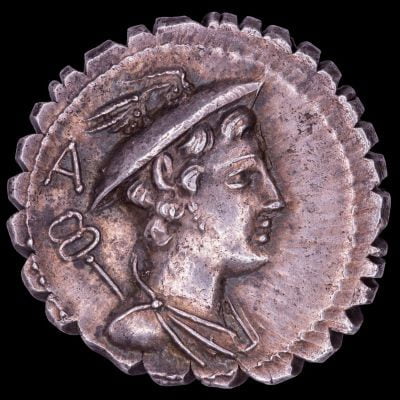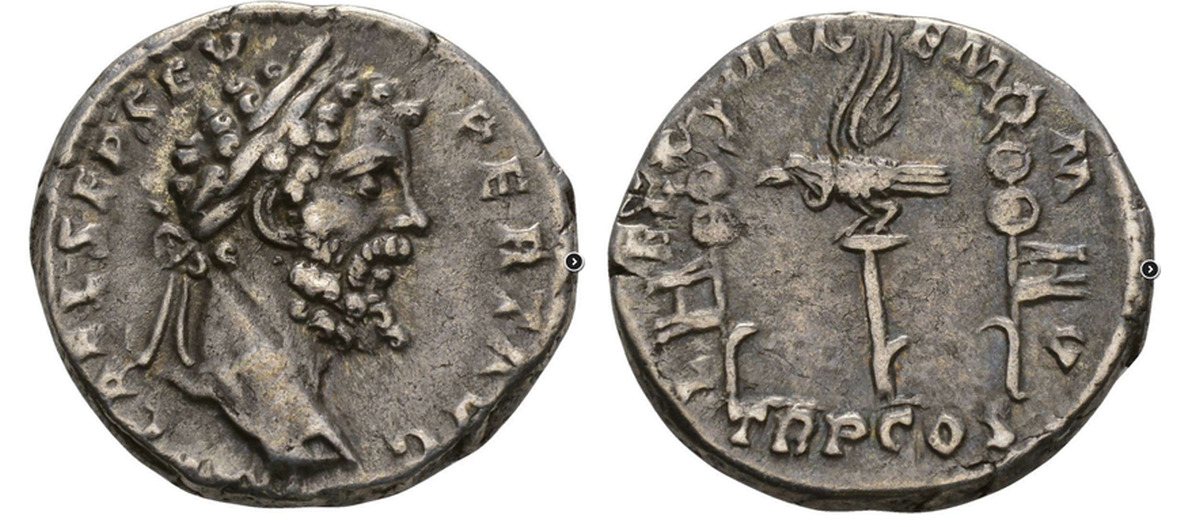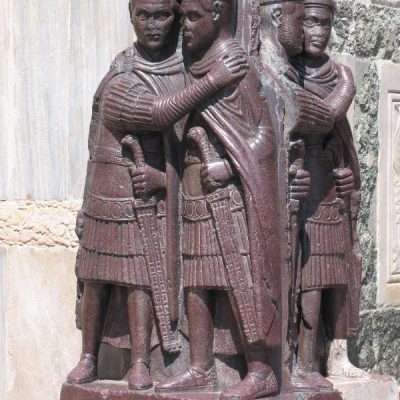Chapters
Inflation is not a problem today. The falling value of money is one of the factors adversely affecting the progressive increase in prices, which in turn leads to destabilization of the economy and social unrest. As it turns out, ancient Romans had to face similar problems.
Brief history of Roman money
Originally, the state property of Rome was kept in the form of herds of cattle. Thus, a Roman going “shopping” made a “transaction” with the help of his cows. Interestingly, theft was defined by the word peculatus, which referred to cattle and meant stealing animals.
The situation changed when the Romans began to deal more and more with the Greeks living in southern Italy (so-called Great Greece). Scientists indicate the probable time of the appearance of a new means of payment in the middle of the 5th century BCE. aes rude. For each transaction, the appropriate amount of aes had to be weighed out. It is possible that in 406 BCE, during the siege of the Veins, the soldiers were paid with this new means of payment. It should be noted that bronze was a cheap metal and was made of 90% copper and 10% tin. The pure metals were weak and the tin strengthened the material.
In the 3rd century BCE, the first counterfeit bronze money appeared, referred to by the term aes grave, to mint its own money during the Second Punic War (218-201 BCE) a silver coin – denarius. The minting of the gold coin – aureus – was not officially launched until the reign of the first Roman emperor, Octavian Augustus (27 BCE – 14 CE).
It should be mentioned that the victory against Carthage in the Second Punic War opened the way for Rome to expand beyond Italy, and subsequent conquests regularly provided treasures and funds that secured the budget and improved the well-being of citizens. For example, the enormous loot that the Romans gained during the Third Macedonian War allowed them to fill the state treasury to such an extent that in 167 BCE the direct taxation of Roman citizens was abandoned.
Corruption of money
We can observe the first problems in monetary policy between the end of the 1st century BCE and the end of the year 84 BCE. Then in Rome there was a decrease in confidence in the denarius and the high prices that resulted from the so-called wars with allies and the economic collapse of the state. This is mentioned by Cicero in his treatise De Officiis1, stating that money at that time lost so much value that no one knew how much he really had. Hyperinflation also resulted from the wrong decisions of the people’s tribune Drusus Livius, who “spoiled” the coin by adding 1/8 part of the bronze to the silver. In this way, plated coins, i.e. with a smaller amount of silver, were introduced to the market on a large scale. The changes were withdrawn by praetor Marcus Marius Gratidianus, who appointed a special commission to recognize defective coins, redeem them and exchange them for good denarii.
The aforementioned procedure of releasing the so-called Clad coins, i.e. coins with an outer coating of precious metal (e.g. gold or silver), when the centre was mostly an inferior metal (iron, copper or bronze), dates back to the middle of the 2nd century BCE serrated coins (denarii serrati), i.e. the issued coins had to have specially cut edges in order to be able to easily verify the value of the coin by looking at its cross-section.
Moreover, under the dictatorship of Cornelius Sulla (82-79 BCE), the lex Cornelia de falsis law was implemented, which prohibited the circulation of coins false in practice, however, the denomination was still spoiled. I mean, of course, by mentioning:
- plating – an interesting example is Mark Antony, who, according to Pliny the Elder, was supposed to add iron to the denarius2;
- and lowering the amount of precious metal in the coin, thereby reducing its weight.
The corruption of money continued under the rule of emperors
Octavian Augustus’ victory in the civil war that followed Julius Caesar’s death in 44 BCE did not end his financial problems. The Roman state departed from an expansionist policy in favour of stabilizing and maintaining borders – there was the so-called pax romana (“Roman peace”). The lack of conquests meant, however, a smaller number of slaves flowing to the Roman market, less loot and acquired precious metals. In addition, subsequent Roman emperors expanded their administrations, increased the remuneration of the army, which guaranteed the stability of the power, and organized huge games to ensure the support of the population and internal peace.
The constantly increasing expenses of the emperors, in the face of the declining proceeds from wars, caused the value of money to decline, and the emperors continued to reduce the amount of gold in the coin. Nero during his reign, in 64 CE, devalued Roman coins – the content of gold was reduced: in silver by 14%, in zlotys by 7%. Despite various reductions, however, the ratio of aureus to denarius was still the same: 1 to 25. Naturally, apart from the decrease in the real value, the weight of the coin was reduced to 7.27 g. Under Marcus Aurelius, the denarius contained only 76% silver.
Septimius Sever (193-211 CE) lowered the pure silver content of the coin to around 47% at the end of the 2nd century; thus the Septimius denarius was worth half the Octavian August’s denarius from the beginning of the 1st century CE Caracalla (211-217 CE) also reduced the amount of aggregate and the aureus already weighed 6.5 g Certain modifications in denarii also fall on the reign of Caracalla, which issued a coin replacing the denarius – the so-called antoninianus – in 215 CE. Antoninianus was often called a double denarius and it had a value of 2 denarii and a weight of 5.1 g. At first, it was a silver coin, later it was minted from bronze and covered with a thin layer of silver.
Crisis of the 3rd century
After the death of Alexander Sever in 235 CE, the last member of the Syrian dynasty, there was an economic and political crisis. It is commonly referred to as the “crisis of the third century”. At that time, the Roman Empire, constantly destabilized by internal struggles for power, had to defend its borders against attacks by neighbouring peoples and states.
The crisis of the third century has also been called by historians “the age of anarchy”; “transition period”, “era of soldiers-emperors” and “military monarchy”. The visible symptom of the crisis was political destabilization as manifested by the rapid changes of emperors, from Septimius Severus. Most of them rose to power through military coups, held power for several months, and often died at the hands of their own soldiers in the course of another coup. In total, in the years 235-284 CE at least 51 people received, legally or not, the title of emperor.
The need to defend the borders against the invasions of the Germanic tribes and the Persian army forced the emperors to over-expand their army, the cost of which increased and the Roman economy was unable to bear them. Emperors imposed enormous fiscal burdens on the population and made up for the shortages of the treasury by constantly spoiling the coins. The denarius – still the basic Roman coin – originally contained 4.5 g of silver; by the end of the 3rd century CE, it was in practice a copper coin with a small admixture of silver. Such actions led to severe hyperinflation that hit society. Interestingly, the tax authorities stopped collecting the tax in a worthless coins; instead, payment in products was preferred. Thus, the imperial economy returned to the commodity economy of the kingdom period.
As a result of the political destabilization of the Empire and the constant struggle, trade within the Empire clearly decreased. Merchants did not feel safe on the routes, while the big owners of latifundia, instead of exporting their goods to the outskirts of the country, preferred to act locally. Social stratification also deepened. Small farms collapsed – they were bought or, on their own initiative, were handed over to noblemen. Protection (patrocinium) guaranteed a chance of survival and shaped the colony layer.
Diocletian reforms
In 284 CE, Diocletian came power (ruled from 284 to 305 CE), who drew conclusions from the experience of previous decades and carried out a thorough reform of the Roman state. By focusing first on political stabilization, he realized that one person could no longer manage such a vast territory. It was impossible to react quickly and effectively in specific situations that occurred at distant ends. Therefore, he introduced a system called the tetrarchy. The emperor appointed a co-ruler with the title of Augustus and entrusted him with the management of the western part of the country – this position was entrusted to Maximian. Diocletian remained in the East but retained sovereignty over all the rest. Each of Augustów sought out a deputy with the title of Caesar to help him; Diocletian chose Galerius, and Maximian chose Constantius. The division of power in the Empire was to facilitate the rule of a large country, but additionally caused progressive bureaucratization, which required more and more financial outlays.
In 294 CE, the currency was relatively regulated through the actions of Diocletian. The reforms were ambitious, but not fully addressed due to a shortage of silver; thus the new coin – follis – was gradually spoiled and over time it lost any payment function. Attempts were also made to repair the budget through the possibility of partial payment of taxes on agricultural products. However, all these changes did not bring about a visible improvement in the situation. Diocletian, along with the expansion of bureaucracy, which resulted from the appointment of three co-ordinates and the implementation of subsequent construction programs, including in Nicomedia, was unable to find savings. Therefore, at the end of 301 CE, he introduced the Edict on Maximum Prices which centrally imposed max prices for services and goods. The edict not only failed to improve the system but also created a black market, which only further worsened the country’s economic situation. After Diocletian’s departure from power in 305 CE, the edict ceased to apply.
Fall of Rome
Progressive deterioration of money and inflation are cited as some of the factors that weakened the Roman state, caused unrest, and ultimately led to political instability and its collapse. Successive rulers had problems with paying for the army and with their recruitment, which in turn influenced its quality and the lack of trust of the population in the central authority. Local lords began to gain a voice, taking under their “protection” clients and creating independent rulerships with private armies. Additionally, the Roman Empire was officially divided in CE 395 by Theodosius I between his two sons: Honorius and Arcadius; and the borders were easily crossed by successive hordes of barbarians who robbed Roman lands.
The existence of the Roman state in the west officially ended on September 4, 476 CE, when the German leader Odoacer forced the Western Roman emperor Romulus Augustulus to abdicate and sent the imperial power insignia to Constantinople – Emperor Zeno. Thus, it was declared that the West would no longer need a separate emperor. This is only an official date; It should be noted, however, that the Roman state from the end of the 4th century CE was a colossus on clay legs, with no real possibility of counteracting internal and external problems.












